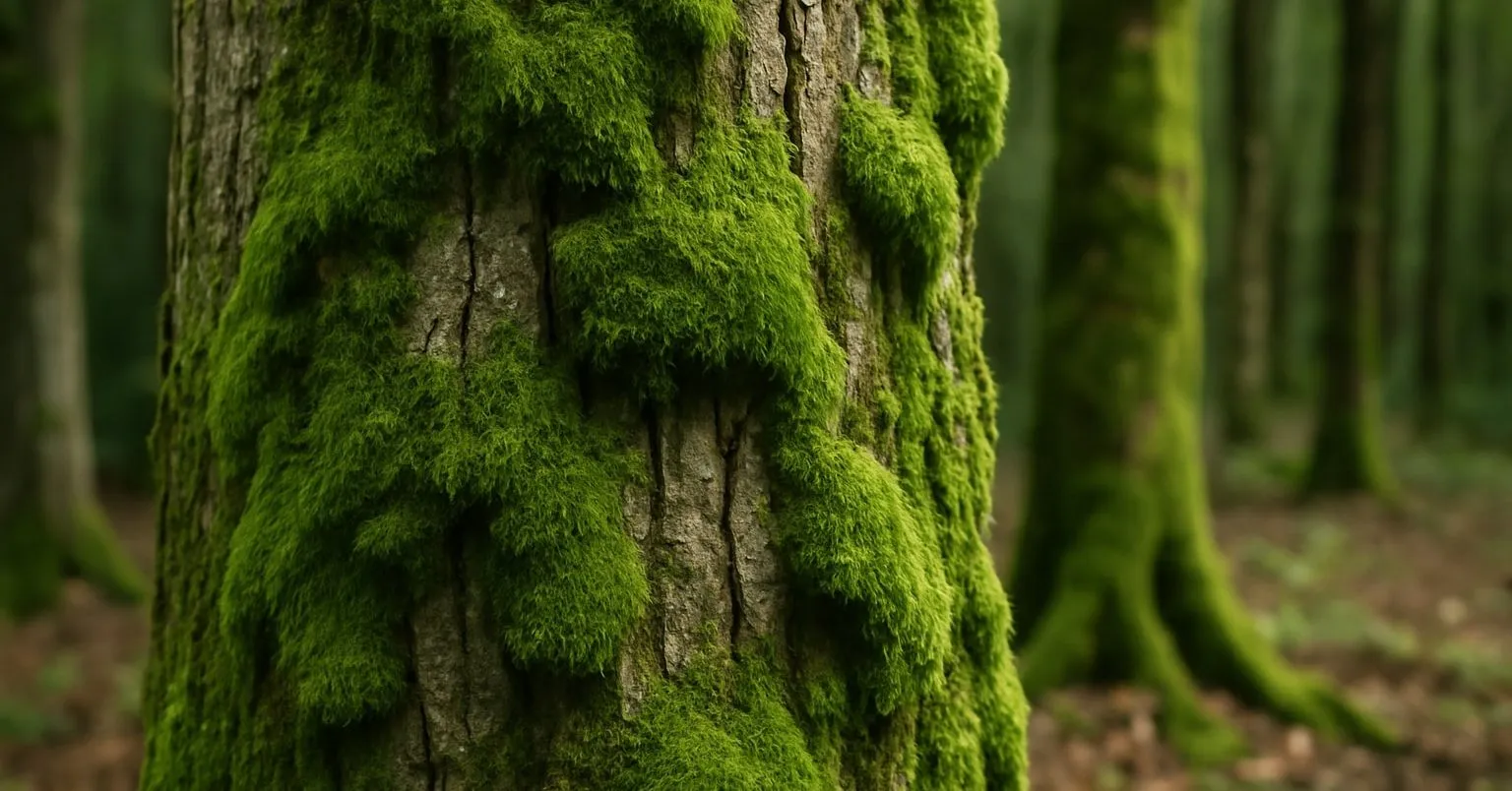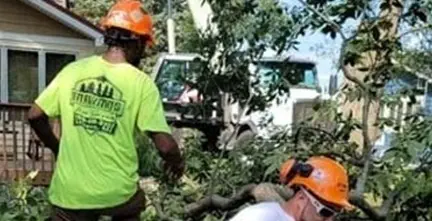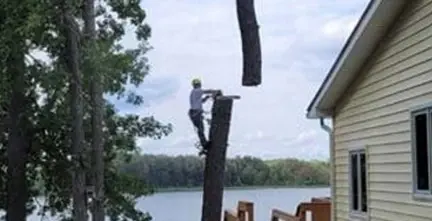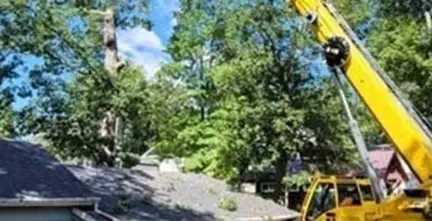If you’ve seen moss spreading across the bark of your trees, it can look strange or even concerning. Many homeowners in Calhoun and Kalamazoo County ask the same thing: is moss bad for trees? The short answer is no, but it can lead to hidden problems if ignored. Moss doesn’t draw nutrients from trees, but it can hold moisture, hide cracks or fungi, and signal that your tree isn’t getting enough light or airflow.
This guide explains why moss appears, how to remove it safely, and how to keep it from coming back.
Why Moss Grows on Trees
Moss thrives in shady, damp areas with poor air circulation. It often shows up on trees that don’t get enough sunlight or have compacted soil that traps moisture. In Kalamazoo and nearby areas with humid weather, these conditions are common.
Conditions that help moss grow:
- Dense canopies that block sunlight
- Limited air movement between branches
- Prolonged humidity or rain
- Wet, compacted, or poorly drained soil
Moss spores are everywhere in the environment. Once they land on a moist surface, they grow quickly.
Is Moss Bad for Trees?
Moss itself doesn’t harm trees directly. It simply grows on the bark surface. The problem is what it can hide. When moss covers a large portion of the trunk, it traps moisture and makes it harder to notice cracks, decay, or fungal infections. Over time, that excess moisture can weaken bark or promote rot, especially on young or stressed trees.
So while moss isn’t toxic or parasitic, it’s often a sign that your tree needs better growing conditions such as more sunlight, airflow, or drainage.
Safe Ways to Remove Moss from Trees
The safest way to remove moss is by hand. Avoid aggressive brushing or using strong chemicals, which can damage the bark.
- Step 1: Gently Remove the Moss
Use a soft-bristle brush or gloved hand to peel away moss from the trunk. Do this on a dry day, as dry moss comes off more easily. Avoid wire brushes or metal tools that can scratch the bark. - Step 2: Increase Sunlight and Airflow
Trim overcrowded branches so light reaches the trunk. Clear nearby shrubs or vegetation that keep the area damp. This also helps prevent moss from returning. - Step 3: Improve Soil and Drainage
If water tends to pool near your tree, redirect it or loosen the soil to improve drainage. Aerating compacted soil allows oxygen and nutrients to reach the roots. - Step 4: Apply a Natural Moss Treatment
A simple baking soda mix can help. Combine 2–3 tablespoons of baking soda with one quart of water and spray it on the moss. It changes the bark’s surface pH, making it harder for moss to grow.
You can also use iron-based moss killers that are safe for trees when applied correctly. Always follow the product label carefully.
Common Moss Problems and Solutions
| Problem | Cause | What to Do |
|---|---|---|
| Thick moss on trunk | Too much shade and moisture | Gently brush off and prune for sunlight |
| Moss keeps returning | Poor drainage or compacted soil | Aerate soil and reduce watering |
| Bark cracking under moss | Possible decay or fungus | Call an arborist for inspection |
| Moss high in canopy | Dense upper branches | Schedule professional pruning |
How to Prevent Moss from Coming Back
The easiest way to manage moss is to make your trees less inviting to it. Healthy trees with good airflow and balanced moisture rarely develop moss buildup.
Prevention checklist:
- Trim branches regularly to let sunlight in
- Improve airflow between trees and shrubs
- Avoid overwatering and fix drainage issues
- Check bark and roots each season for signs of stress
In areas like Calhoun and Kalamazoo County where humidity is common, regular tree inspections are an effective way to catch early signs of moss or decay.
What Most People Get Wrong About Moss
Many people assume moss kills trees. It doesn’t. Moss grows on trees that are already struggling with shade, moisture, or soil issues. If you only focus on scraping it off, it will come back again and again. Real moss control comes from improving the environment around the tree, not just cleaning the bark.
A Real Example from Calhoun County
A homeowner once called about an oak tree covered in thick moss. They thought it was dying. After inspection, we found that the soil was heavily compacted, cutting off oxygen to the roots. Once we aerated the soil and thinned the canopy, the moss began to fade naturally. The tree recovered without chemicals. This is a good reminder that moss often signals a deeper problem rather than being the cause itself.
Getting Started with Moss Removal
If you want to start small, try these simple steps:
- Brush away loose moss during a dry period
- Spray a mild baking soda solution
- Trim a few branches for sunlight
- Watch for signs of hidden bark damage
Even basic care can make a noticeable difference.
Frequently Asked Questions About Moss on Trees
Does moss kill trees?
No, moss doesn’t kill trees. It simply grows on the surface of the bark and doesn’t take nutrients from the tree. The issue is that moss traps moisture and hides signs of decay, cracks, or fungi. Over time, that moisture can soften bark and lead to rot, especially in damp or shaded areas. If your tree already struggles with poor drainage or limited airflow, moss can make those problems worse. It’s a sign that your tree needs more sunlight or better soil conditions.
Should I remove moss from my oak or maple trees?
Yes, it’s a good idea. While moss won’t harm oak or maple trees directly, it can block airflow and cover early signs of disease or bark damage. Removing it helps keep the bark dry and healthy. Just use a soft brush or gloved hand to peel the moss gently. Avoid metal tools or pressure washers, as they can scrape bark and create wounds that attract pests or fungi.
Can I pressure wash moss off a tree?
No. Pressure washing may seem like an easy solution, but it can cause serious damage. The strong water pressure can strip away the tree’s protective bark layer and create openings where insects or disease can enter. Always remove moss by hand using gentle tools. If the moss covers a large portion of the trunk or branches, consider hiring an arborist to do it safely.
What’s the fastest way to get rid of moss on trees?
The quickest safe methods include using a baking soda spray or an iron-based moss killer made for plants. Baking soda changes the bark’s pH, making it harder for moss to grow, while iron-based products dry out the moss without harming the tree. However, these are temporary fixes. If you don’t improve sunlight, drainage, or airflow, moss will return within months. Combine treatment with pruning or soil aeration for lasting results.
Will moss go away on its own?
Sometimes it will, especially if your tree naturally gets more sunlight or wind during certain seasons. In drier months, moss can dry up and flake off on its own. But in humid areas like Calhoun and Kalamazoo County, moss usually comes back unless the conditions that caused it change. Improving sunlight and drainage around the tree gives you a more permanent solution.
Is moss a sign that my tree is sick?
Not always. Moss often grows on perfectly healthy trees, especially in shady or moist areas. But if the moss is thick or spreading quickly, it might be hiding something more serious like bark decay or fungal growth. If the bark feels soft or smells musty underneath the moss, schedule a tree inspection to make sure there’s no hidden damage.
Can moss harm young trees more than mature ones?
Yes. Young trees have thin bark that holds moisture more easily. When moss grows on young bark, it keeps the surface damp and can slow down growth. Mature trees with thicker bark are less sensitive, but they can still develop rot if moss traps too much moisture. If you notice moss on saplings or recently planted trees, remove it early and increase sunlight exposure.
When should I call a tree service for moss removal?
Call a professional if moss covers a large part of the trunk, reaches high into the canopy, or hides visible bark cracks or peeling. Arborists have safe methods to remove moss without harming the tree, and they can inspect for decay or insects underneath. In areas like Calhoun and Kalamazoo County, most homeowners schedule moss inspections in spring or fall, when pruning and soil care are most effective.
Final Thoughts
Moss is not the enemy of your trees, but it’s a sign worth paying attention to. It grows where trees are under stress from shade or moisture. Removing it safely, improving airflow and drainage, and scheduling regular inspections will keep your trees strong and healthy.
If you’re in Calhoun or Kalamazoo County and notice moss on your trees, consider a professional inspection from Brawner’s Tree Service in Battle Creek MI. A simple visit can prevent long-term damage and keep your landscape looking its best.




